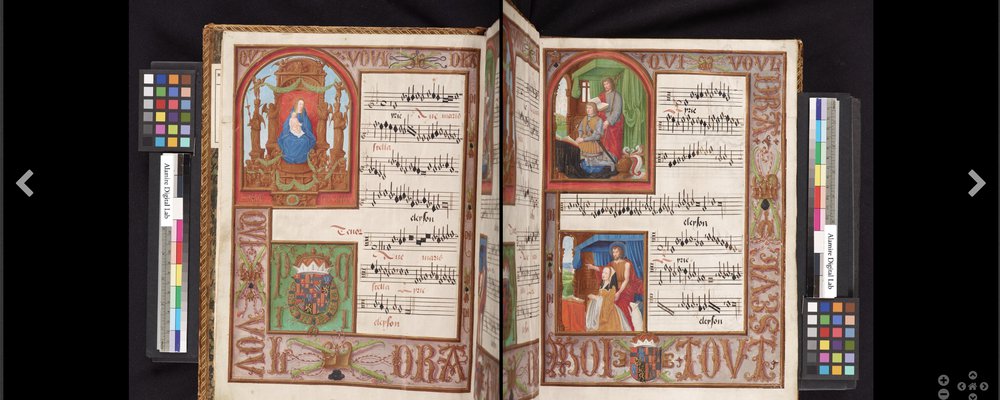Integrated Database for Early Music (IDEM)

IDEM (B-Br-9126 f. 1v-2r © KBR, Alamire Digital Lab)
This project aims to create a multifaceted database for researching, studying, and performing medieval and Renaissance music (up to the year 1600) in the Low Countries. IDEM intends to create a unique instrument for the preservation, study, and valorisation of the Low Countries’ cultural heritage, including both sources presently kept in the Low Countries, and sources held abroad but directly related to the region. The database will integrate digital images of primary musical sources (manuscripts and prints) with the most important tools for studying the sources’ immediate context.
IDEM will offer a vital tool for researching and understanding medieval and Renaissance music in at least three respects.
- First, IDEM will offer much wider and freer access to the sources than is currently the case. Presently, much important musical patrimony is only selectively available to most scholars. Furthermore, given that much material is still held in smaller archives and ecclesiastical institutions rather than large research libraries, even when material is in principle available, it may still be difficult to obtain in practice.
- Second, the images that the database will hold will be of a quality far higher than typically offered by the reproduction services of the libraries, archives, and other institutions that hold the original sources.
- Third, the databases will offer not only images of the sources themselves but also state-of-the-art information on a varied range of aspects related to the sources and their contents. These will include physical aspects of the source, illuminations and other artistic elements, texts, recordings, editions of the pieces, and guides to performing directly from the original notation.
The proposed database will cover not only polyphonic music but also Gregorian chant. This is vital to promoting better understanding of medieval and Renaissance music. The proposed database will stimulate a more holistic view by bringing the two into relation with one another.
IDEM contributes not only to excellent and innovative research, but also to the long-term safekeeping and conservation of precious sources.
By offering primary sources and secondary material under a single umbrella, the database will facilitate the research not only of musicologists, but also of literary and art historians, as well as performers and practice-based researchers. The database will thus counter increasing specialisation by providing an essential interdisciplinary research tool. By gathering together different sorts of information that are usually studied in isolation, the database will promote a novel synthetic and broadly interdisciplinary understanding of medieval and Renaissance music and musical culture.
Constituent databases
- A thorough understanding of medieval and Renaissance music must begin with studies of the primary surviving sources. The core of the proposed database will thus consist of an image database that will contain images of manuscripts and imprints containing Gregorian chant and polyphony. These images will be made with the most advanced technology available, and at a resolution-level that will enable the researcher to magnify and examine the tiniest details of the source. This is essential for the study of palaeographic aspects of a source, such as scribal hands, layers, palimpsest manuscripts, and erasures, and has significant implications for current conceptions of, for example, scribal workshops. Such images are far superior to the microfilm or paper copies that researchers are currently forced to use if they cannot examine the source in person. Indeed, they can actually offer invaluable data that is partly or entirely invisible to the naked eye, and thus only apparent via high-resolution images, which may subsequently be manipulated by digital restoration.
- A second image database will focus on music manuscript illuminations and handwriting. It is anticipated that substantial extensions to this database will be possible through partnerships with Illuminare, KU Leuven’s Centre for the study of the illuminated manuscript, and with similar centres. This database will make a significant contribution to the study of medieval and Renaissance manuscript iconography by offering both a comprehensive overview of illuminations found in musical, liturgical, historical and narrative sources, as well as comparative material for the study of the dissemination and function of iconographic topoi common or specific to certain periods, regions, or source types.
- A third database will focus on the texts of vocal works. This database will not only contain the texts found in the sources that are digitised, but will also offer the possibility of comparing variant text versions between sources and between works that set similar but not absolutely identical words. The thorough and detailed comparisons that this database will facilitate are an essential starting-point when researching the provenance, dating, and identification of medieval and Renaissance compositions. At the same time, this database will form an entry-point for scholars of medieval and Renaissance literary traditions, by offering an important tool, for example, for the study of the reception of Classical, biblical and humanistic texts. At a later stage of development, it is planned to add translations of all texts
- The fourth database will provide transcriptions and critical editions of sources in the image database.
- A fifth database will contain so-called “fake-similes”, that is, manuscript images that have been adapted for direct practical use through correcting scribal errors, bringing the words and the music into an unambiguous relationship (it is typical of medieval and Renaissance sources that words and music are matched only in a general way), and adding musica ficta (melodic inflections that were conventionally applied by singers of the time without having to be explicitly notated). The aim of such adapted images is to provide a stepping stone for those wishing to engage with primary musical sources in the same way as their original users did: as documents from which to perform. This database will be particularly stimulating for practice-oriented and practice-based research, and for the collaboration between researchers and performers of the same repertoire.
- The sixth database will contain audio files of the music in the image database. It is clearly vital that researchers, performers, and students of medieval and Renaissance music have the opportunity to come into immediate contact with the compositions not only as written entities but as sounding works. The database will aim in particular to gather rare recordings and recordings of rarely performed pieces. The database, however, will offer more than simply the opportunity to hear performances of works under study. The interpretation of the music of the Middle Ages and Renaissance is a hotly debated topic. Thus the possibility that the database offers for comparative research into performance practice, through providing different versions of the same work, will be of exceptional value. Such comparisons will reveal the extent to which different musical parameters are open to interpretation in performance, including tempo, style, text-underlay and pronunciation, rhetoric, and musica ficta. Furthermore, comparison of older and more recent recordings will enable the investigation of performance practice from a historical perspective.
- A final database will hold the necessary metadata pertaining to all source material. The database will offer material descriptions of the sources, employing the standard criteria of internationally recognised reference works and standard catalogues, such as CAO (Corpus Antiphonalium Officii), AMS (Antiphonale Missarum Sextuplex), RISM (Répertoire International de Sources Musicales), the Cantus Database, and the Census Catalogue of Manuscript Sources of Polyphonic Music, 1400-1550.
